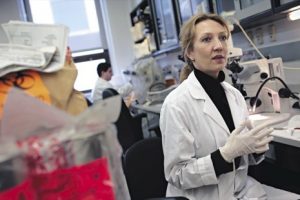You probably never noticed, but much of what your read has a claim/evidence/warrant structure.
Let’s look at another article about this week’s theme. In a 2007 article in the New Yorker magazine, Jeffrey Toobin addressed the shaky science behind much of what we call “forensic science”
Here’s an edited paragraph taken from the middle of that article.
Faber’s brief summary defined the dilemma at the heart of forensic science. “There are

Lisa Faber, the supervisor of the N.Y.P.D. crime lab’s hair-and-fibre unit
really two kinds of forensic science,” says Michael J. Saks, a professor of law and psychology at Arizona State University, and a prominent critic of the way such science is used in courtrooms. “The first is very straightforward. It says, ‘We have a dead body. Let’s see what chemicals are in the blood. Is there alcohol? Cocaine?’ That is real science applied to a forensics problem. The other half of forensic science has been invented by and for police departments, and that includes finger-prints, handwriting, tool marks, tire marks, hair and fibre. All of those essentially share one belief, which is that there are no two specimens that are alike except those from the same source.” Saks and other experts argue that there is no objective basis for making the link between a “q” and a “k.” There is no scientific evidence, no validation studies, or anything else that scientists usually demand, for that proposition—that, say, two hairs that look alike came from the same person. It’s faith-based science.
You’ll see that this paragraph is organized around claim/evidence/warrant.
| Claim | Faber’s brief summary defined the dilemma at the heart of forensic science. |
| Evidence | “There are really two kinds of forensic science,” says Michael J. Saks, a professor of law and psychology at Arizona State University, and a prominent critic of the way such science is used in courtrooms. “The first is very straightforward. It says, ‘We have a dead body. Let’s see what chemicals are in the blood. Is there alcohol? Cocaine?’ That is real science applied to a forensics problem. The other half of forensic science has been invented by and for police departments, and that includes finger-prints, handwriting, tool marks, tire marks, hair and fibre. All of those essentially share one belief, which is that there are no two specimens that are alike except those from the same source.” |
| Warrant | There is no scientific evidence, no validation studies, or anything else that scientists usually demand, for that proposition—that,say, two hairs that look alike came from the same person. It’s faith-based science. |


